Dan Henry Watches 1972 Alarm Chrono Review
By: Greg Bedrosian
When Dan Henry Watches first released the 1972 Alarm Chono I did a mental fist pump. I knew that eventually I’d get the chance to interact with one. I recognized it immediately.
The 1986 film Top Gun was the best piece of PR material ever to grace the United States military. At the time America was still on the heels of the Vietnam conflict. The nasty aftertaste led to low public perception of the US Military. This made military recruiting difficult at best. We didn’t see past the uniforms to the people wearing them and respect them as we do today.
Fictional Naval Aviator LT. Pete Michel was “larger than life” (Editor’s Note: …that’s 1). Volleyball and excessive showering aside, the character’s style and attitude resonated with me as an early adrenaline junkie and chronic envelope pusher. The persona was complete with patches on the leather jacket, a motorcycle, aviator sunglasses, and stonewashed jeans.
The film is riddled with inconsistencies and technical errors, including the most egregious of all: Maverick’s watch. Despite the different watches used in filming, the Orfina 7176s Chronograph is widely considered to be the “Top Gun” watch.
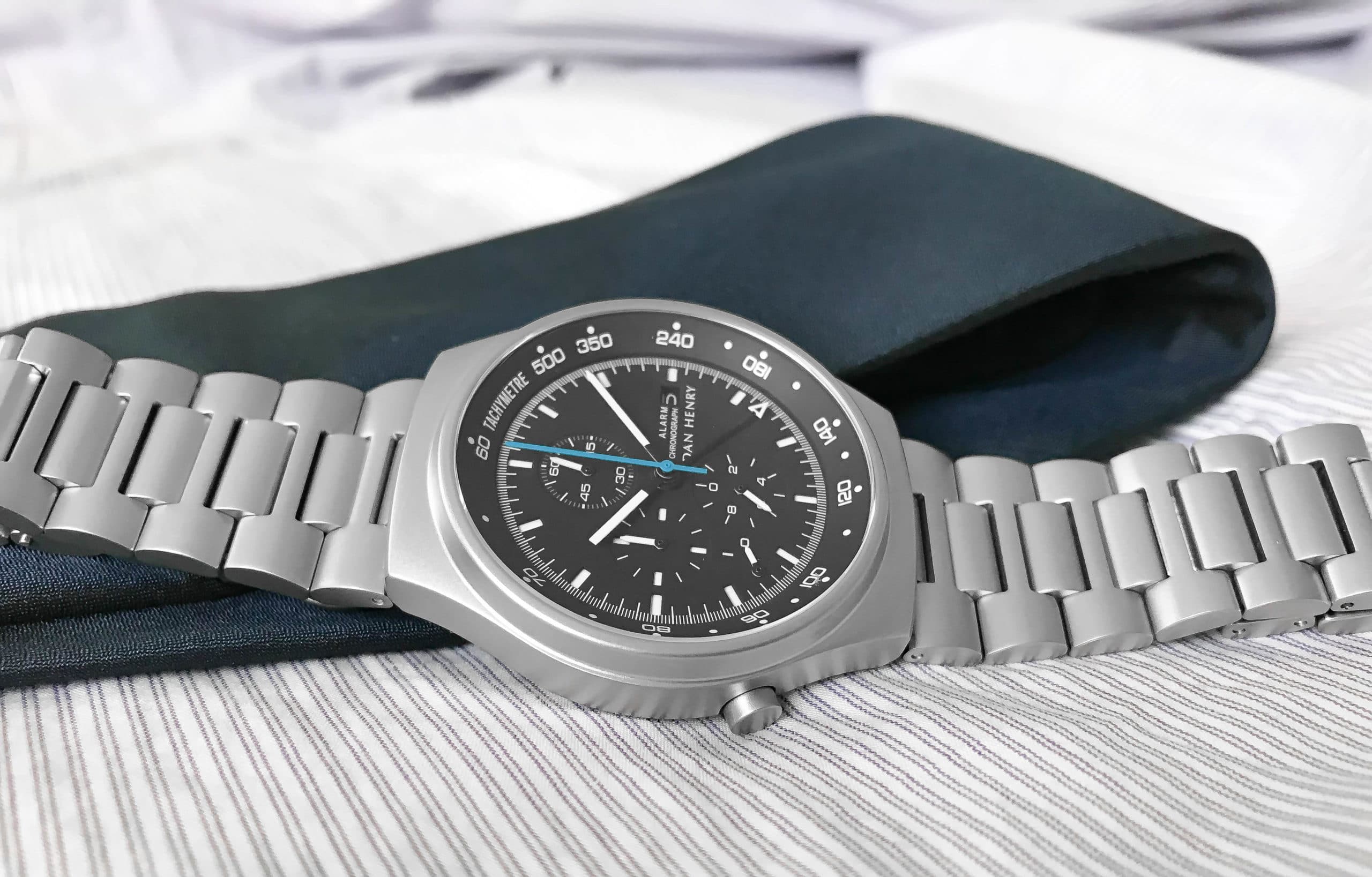
The Dan Henry 1972 Alarm Chrono PVD Black draws large amounts of inspiration from that iconic watch. When I received word that I was going to get to review the Dan Henry 1972 I asked a friend how many Top Gun references I was allowed to use in the article.
He replied, “The hard deck is five” (Editor’s Note: That’s 2).
The watch that I received for review was not the black PVD, it was the matte silver. At first I was disappointed, but then came a sense of relief. I could now objectively review the Dan Henry Watch 1972 Alarm Chrono for what it is, and not what it is not.
The Case:
As mentioned above, the Dan Henry 1972 Alarm Chrono case is distinctly similar to the Orfina 7176s. The stand-out feature is the lugs (or lack thereof). The lug-to-lug on the case is only 45.5mm. This makes the watch wear smaller than the 41mm diameter would suggest.
My favorite part of the case is the color: matte silver. Most cases have a combination of brushed and polished stainless steel surfaces. The Dan Henry 1972 Alarm Chrono’s case is bead-blasted. It gives the silver watch a unique satin finish that feels great while handling. It’s a finish that you don’t see often especially at this price point.
The Dan Henry 1972’s screwdown crown surprised me. This was probably due to handling so many manual wind Speedmasters. Although the crown screws down securely and the watch is rated for 50 meters of water resistance, I wouldn’t swim with it. The crown is stamped with “DH”, another nice detail.
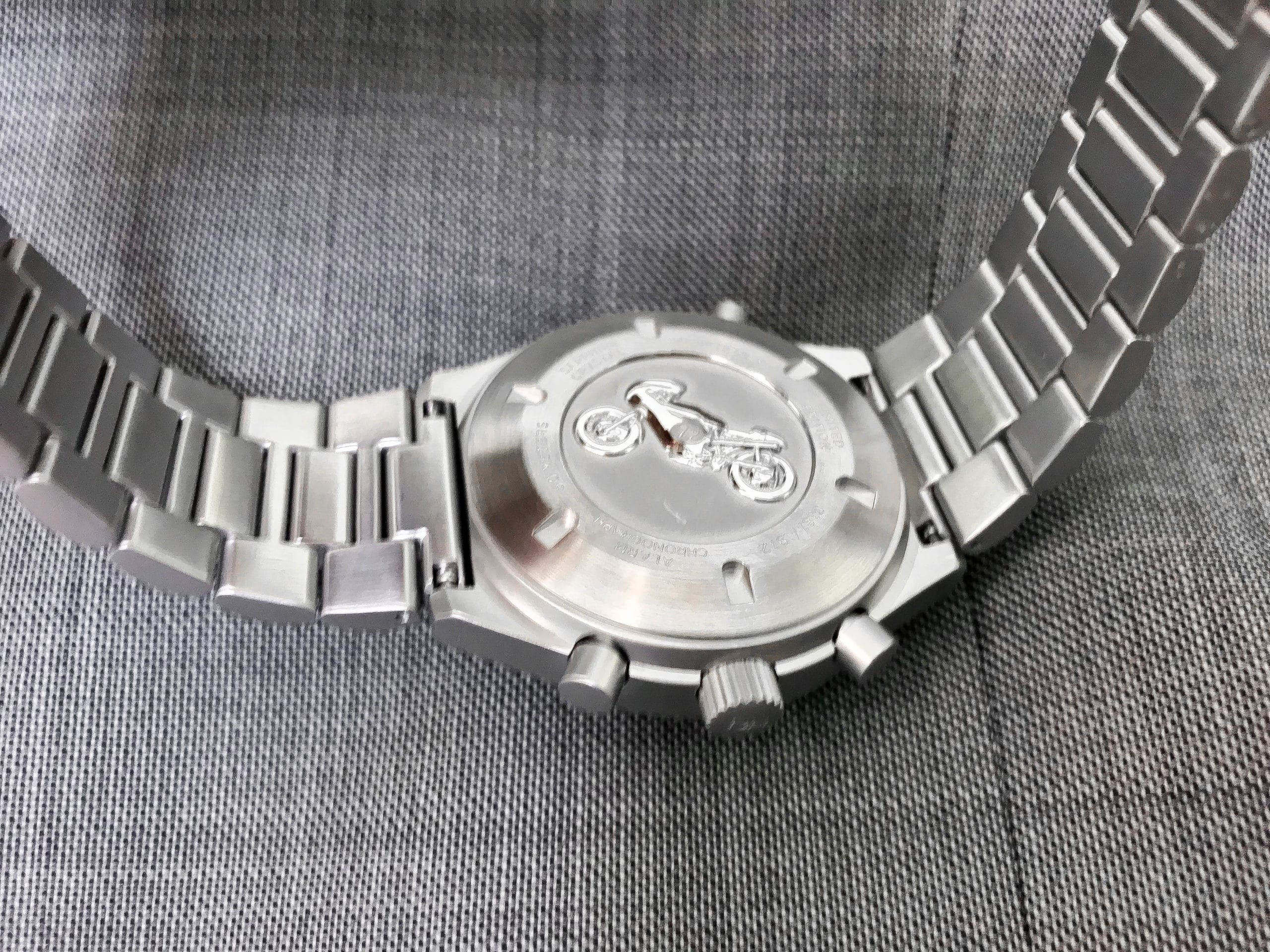
Most 1960’s and 1970’s inspired chronographs have a domed crystal. The Dan Henry Watches 1972 does not. The flat sapphire crystal is one of its most prominent defining features. I was initially concerned about the glare. The anti-reflective coating makes it a non-issue.
Flipping the case over reveals the virtually nonexistent lugs. They cover the endlinks and allow the bracelet to hug smaller wrists if needed. There is also a Ducati motorcycle with the number 72 on the caseback. It is important to note that if you get the black version, the actual caseback will still be polished stainless steel and not black.
Protruding from the side are four controls to manipulate the complications. Three of them are in their expected locations on the right side: the crown, the chronograph start/stop, and the chronograph reset. On the bottom left at 8 o’clock lies the tiny alarm on/ off switch.
The Dial:
This is where the review goes from normal to “ballistic with Penny Benjamin” (Editor’s Note: That’s 3). There are eight hands, three subdials, an on/off indicator, a tachymetre scale, and a date window all packed under the glass.
All of the other chronographs in my collection have the tachymetre scale on the bezel. The Dan Henry 1972 has it on the chapter ring. This is a unique departure from the norm as we see another connection the Orfina 7176s. Placing it there allows for the printing of larger numbers for increased legibility.
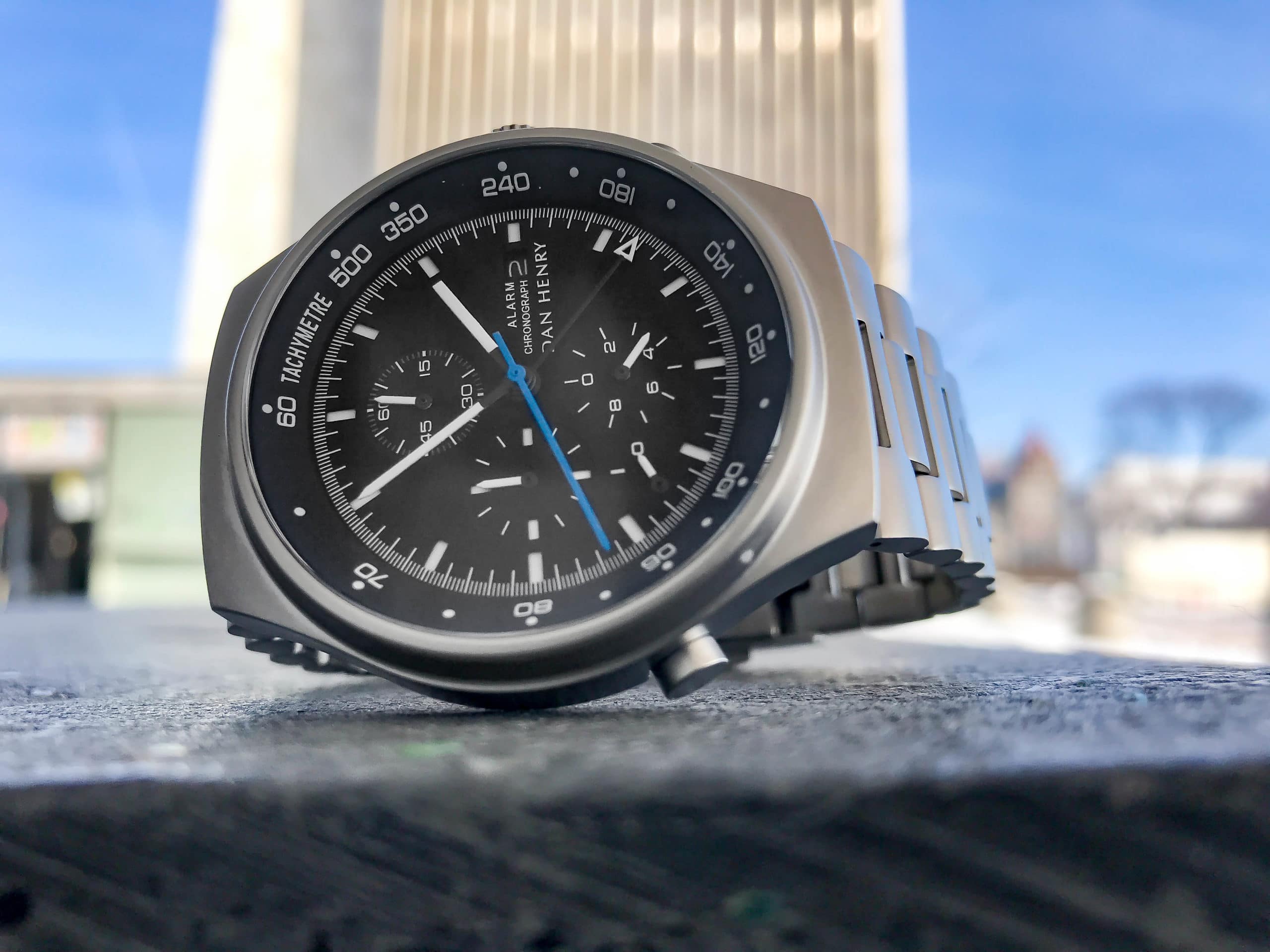
The white hour and minute hands are in contrast to the black dial. This is a busy dial and I was surprised how easily it was to read the time on the 1972 Alarm Chrono. The chronograph seconds hand is blue. I would have preferred red. But the blue does cool the silver down for a cleaner look.
It is not obvious by looking at a two-dimensional picture of the watch online, but the Dan Henry 1972 Alarm Chrono has a sandwich dial. The hour markers and hour subdial crosshairs are lumed and sit below surface to create additional depth.
The 12-9-6 subdial layout is not my favorite. I like subdials neatly tucked in the southern hemisphere of the dial with 3-6-9. I understand that the 12-9-6 is part of the design language and the Dan Henry 1972 Alarm Chrono is one of the only watches where it’s not a deal breaker for me. The bottom subdial is tenths of a second and spins like a top when activated. The top subdial is the elapsed minutes from the chronograph.
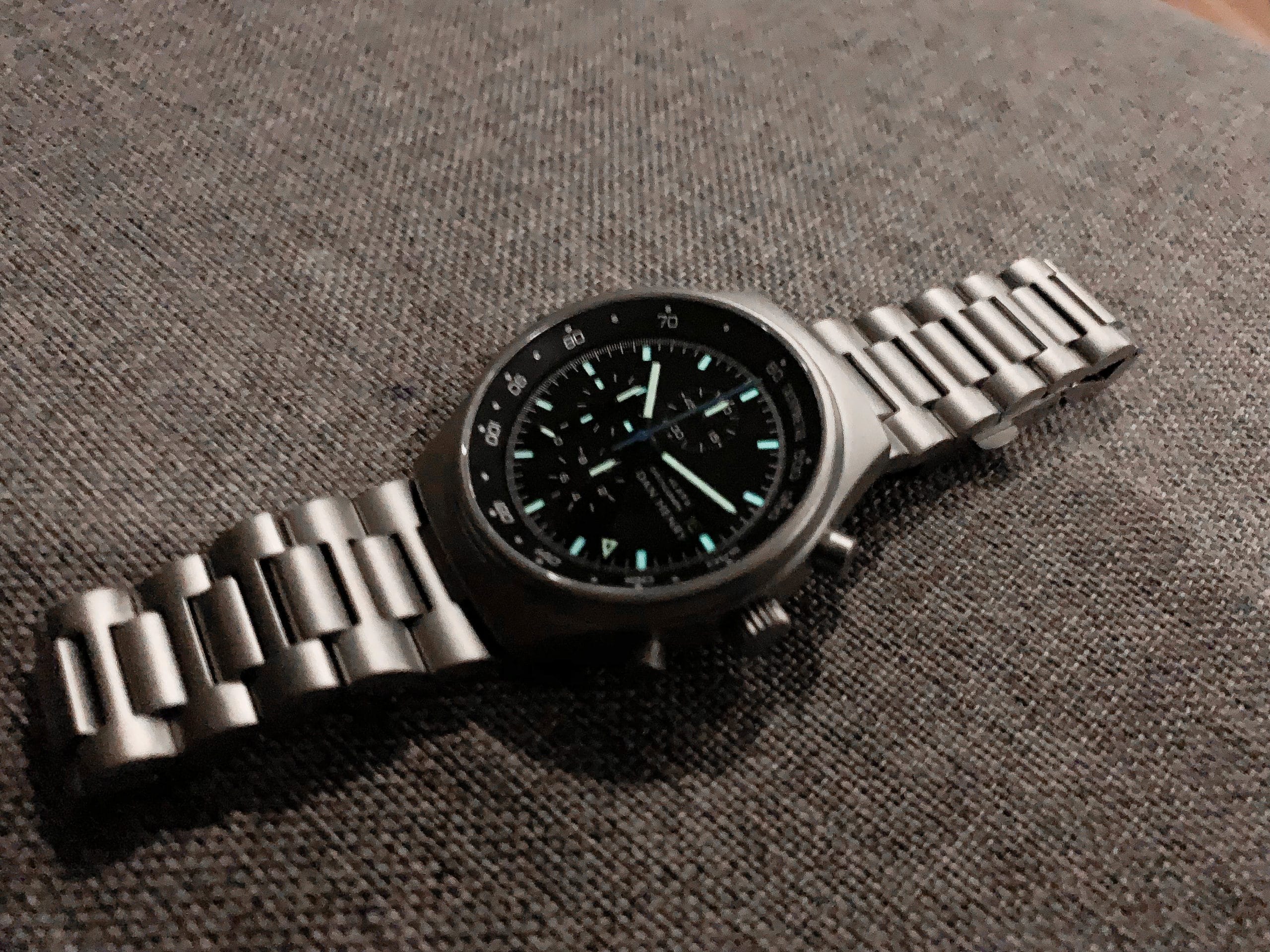
The date window sits at 3 o’clock and is much appreciated. Date windows are the exception, rather than the norm with most classic chronographs. However, the window is small and there is a lot of text surrounding it. The original Orfina 7176s had a day and a date window. There were a few dial variations: “Military”, Porsche Design / “pd”, “Orfina” branded, and blank unbranded. The Porsche Design / “pd” is the most common for the original and for aftermarket replacement dials.
There was a missed opportunity by Dan Henry Watches to experiment with the logo on the dial. My choice for the dial logo would have been to use the “DH” logo found on the clasp and crown. “Alarm Chronograph” could have been tucked under the date window. The current layout is too cluttered and makes the date difficult to read at a glance.
With dial real estate at a premium, the On / Off indicator for the alarm is tucked away at 7:30. There is a little white hand that switches from “O” to “I” when the alarm function is activated.
A long triangular hand extends around the outside of the dial. It is the indicator for the alarm time. This is the feature that separates the Dan Henry 1972 from its classic inspirations. On a Speedmaster Mark 40, this would be the date indicator. It did take me a little while to think alarm and not GMT or pointer-date. When not using the alarm function, the alarm hand can be neatly positioned at 4:30.
The Movement:
The Dan Henry 1972 Alarm Chrono uses a Miyota OS80 quartz movement. There is nothing flashy or innovative here. What you get is an affordable and reliable workhorse. Its complications include: Center Chronograph, Small Second 1/10 Sec Chronograph, Chronograph Minute, 12 Hour, Alarm, and Date. Here is the spec sheet from Miyota.

Note that the Miyota OS80 does not have a running seconds hand. If you don’t like the “tic” on quartz chronographs, this might be the watch for you. The other functions are a little more complicated than your average chronograph. There is no paper instruction manual that comes with the watch. You can either play with the complications until you figure them out, or read the digital instructions manual here.
The real thing that gives the 1972 its own personality is the alarm function complication. On most tool watches we usually see the same three complications: dive timers, chronographs, and GMT hands. How functional are these in our modern everyday lives? They are also all passive functions requiring the user to monitor them. In the case of this alarm you set it and turn it on. The watch does the rest with an old-school set of triple-beeps reminding you when “it’s time to buzz the tower” (Editor’s Note: That’s 4).
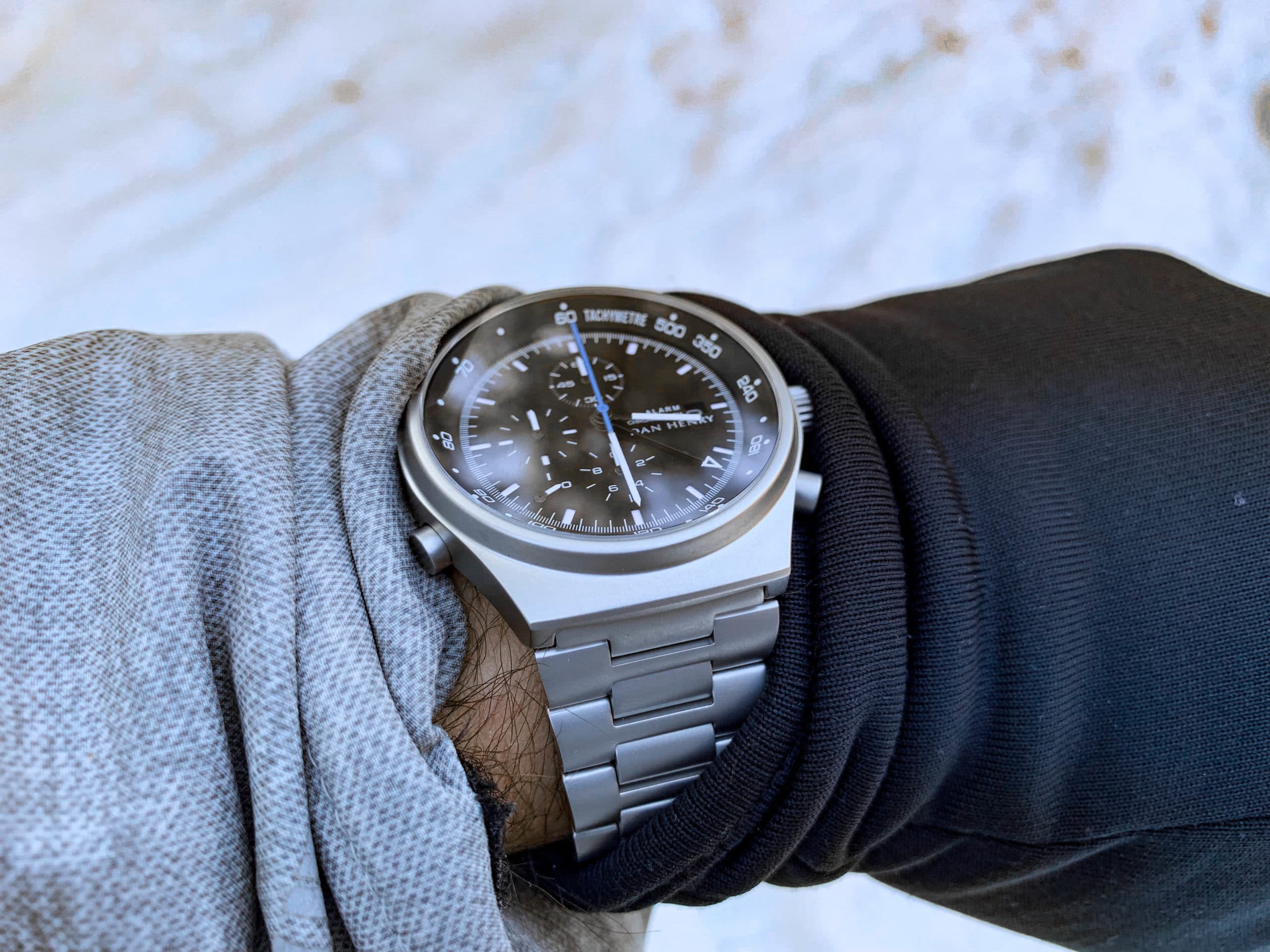
The Bracelet:
Bracelets are usually wildcards with smaller brands. This especially applies to anything paying homage to something else, for example oyster, jubilee, and beads of rice bracelets. The bracelet of the Dan Henry 1972 Alarm Chrono is none of the above. It is reminiscent of Orfina bracelets with a few stand out features.
This first thing that immediately impressed me was how solid the clasp was. The bracelet itself was surprisingly comfortable as well. I usually have trouble finding the sweet spot when sizing a bracelet to my 6.75” wrist.
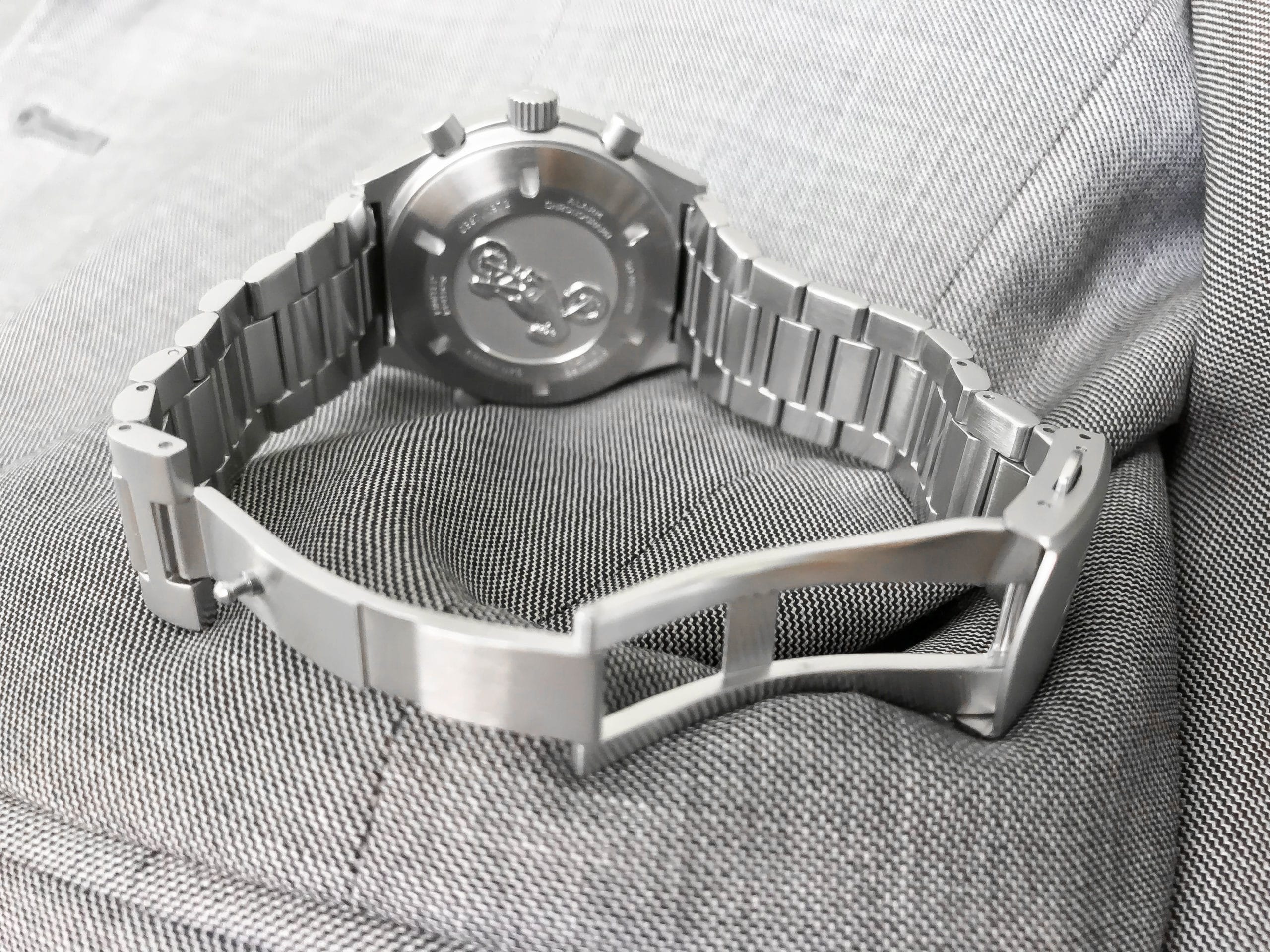
The bracelet dimensions are also uncommon. The actual lug width is 20mm. That is if the lugs actually existed. Due to the unorthodox case shape (mentioned above) the lugs don’t really exist. To make up for that the first link on the bracelet is actually 24mm wide. Don’t let that size fool you. It complements the case design and seamlessly tapers down to a respectable 18mm at the clasp.
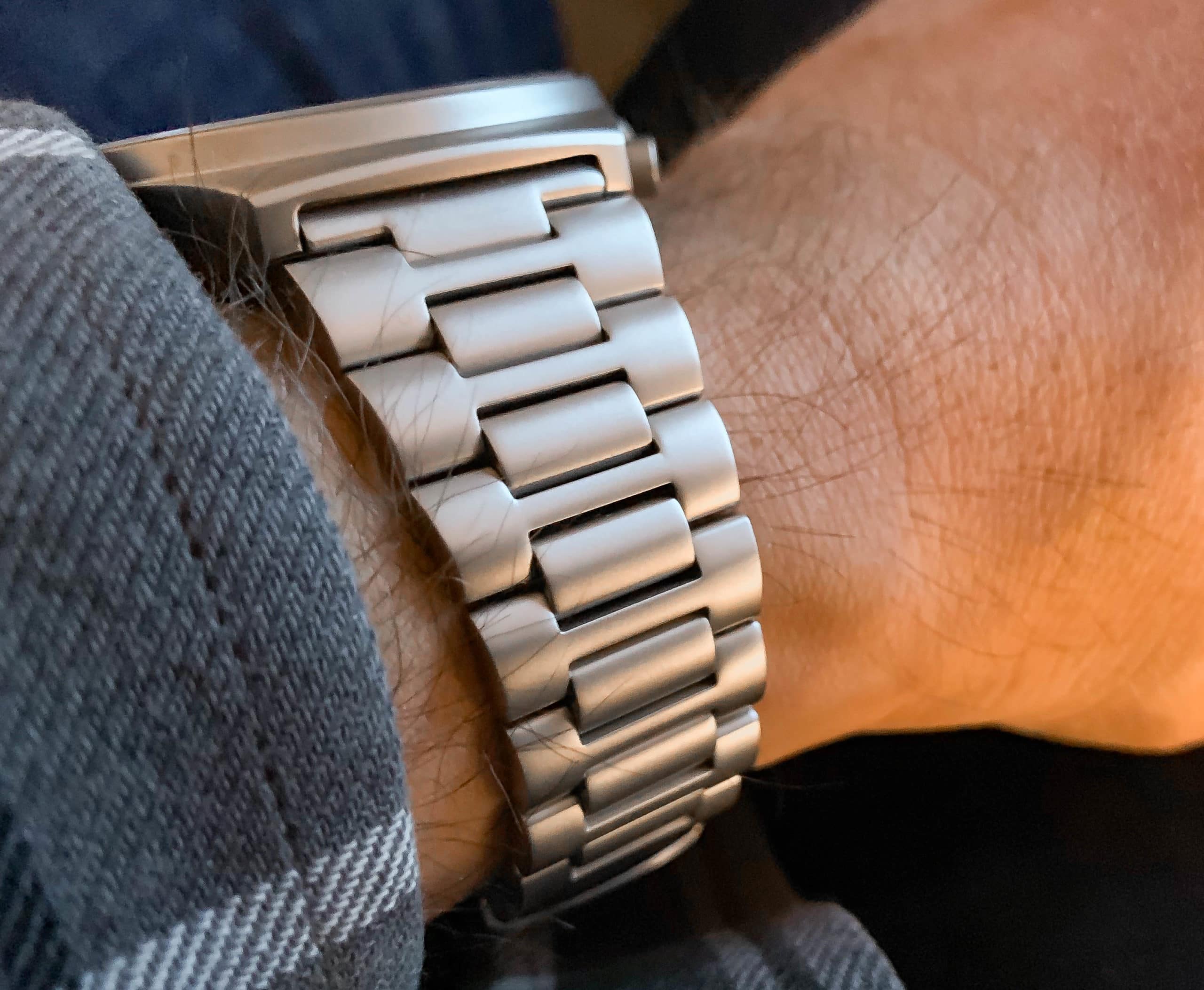
My biggest complaint about the bracelet was the use of pins instead of screws. These pins happened to be some of the most stubborn that I’ve ever come across. Thank goodness sizing the bracelet is something that you wouldn’t have to do often.
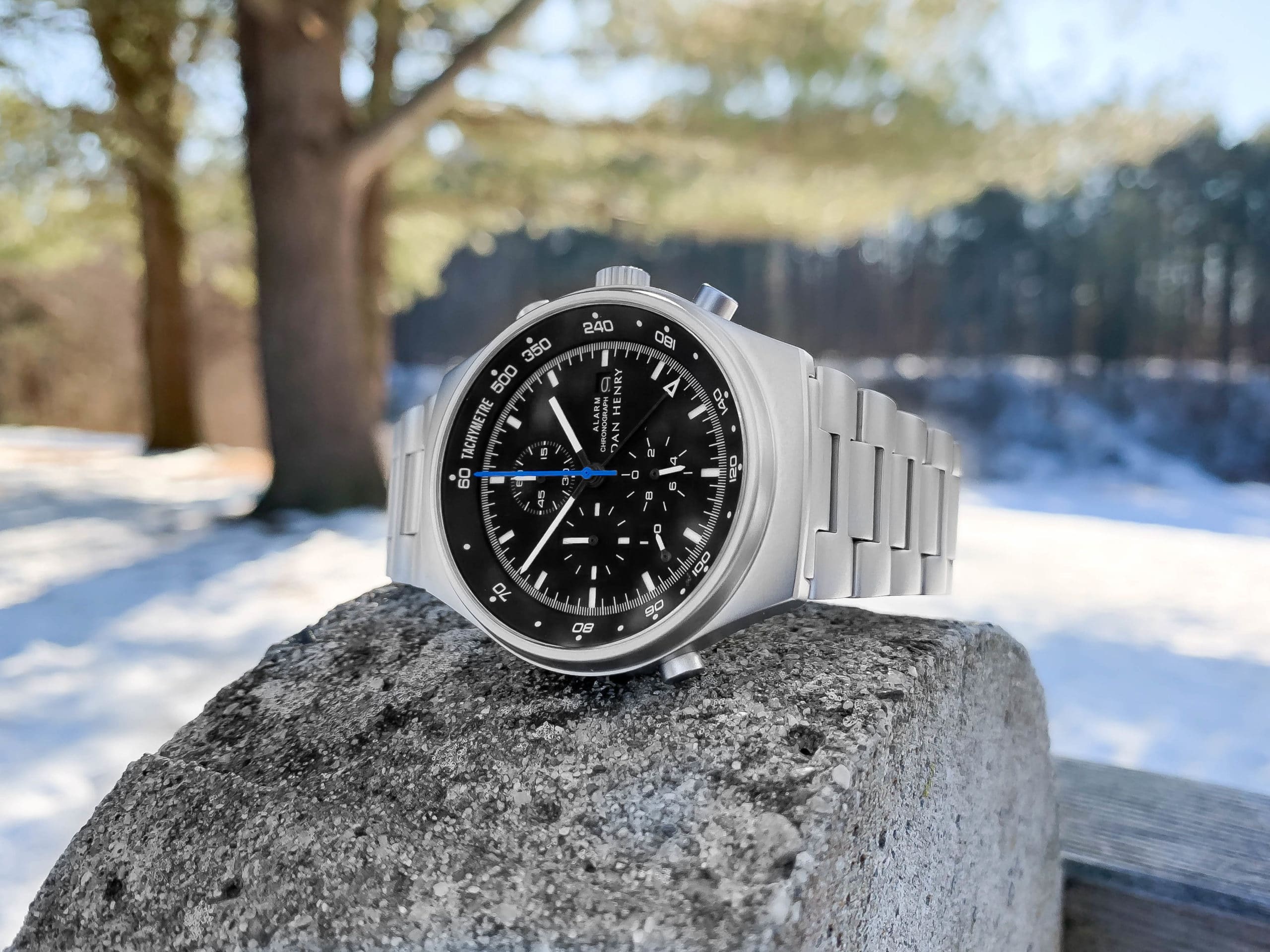
Conclusion:
The knee jerk reaction is to choose Hollywood nostalgia and go with the black Dan Henry 1972 Alarm Chrono. Unless this watch is going to sit next to your 1:48 scale F-14A, consider the matte silver. It’s a much more versatile piece. It’s a fun departure from the norm that can check either the “driver” or “flyer” category as you build an affordable collection.
One of the biggest challenges of the Dan Henry 1972 Alarm Chrono is the competition from other chronographs within the Dan Henry line-up such as the 1963 or 1964. Nevertheless, it’s exciting to see how Dan Henry Watches is continuing to challenge themselves by expanding their catalogue. What could be next (My guess is a 1945 “Dirty Dozen”)?
Before you start “writing checks that your body can’t cash” (Editor’s Note: boom – that’s 5), remember that the Dan Henry 1972 Alarm Chrono is $350. Unfortunately, you can’t use your ego or a check to buy one. Luckily for you the Dan Henry website takes credit cards.
Read more about the history of Dan Henry Watches!

Greg is a long-time watch lover based in upstate New York. Greg is a supply chain professional by day and private watch consultant by night. Greg brings his own style to the TBWS website as a contributor by blending bits of humor into technical assessments. You can follow his cycling and snowboarding adventures on Instagram as he pursues the perfect 3-watch collection.


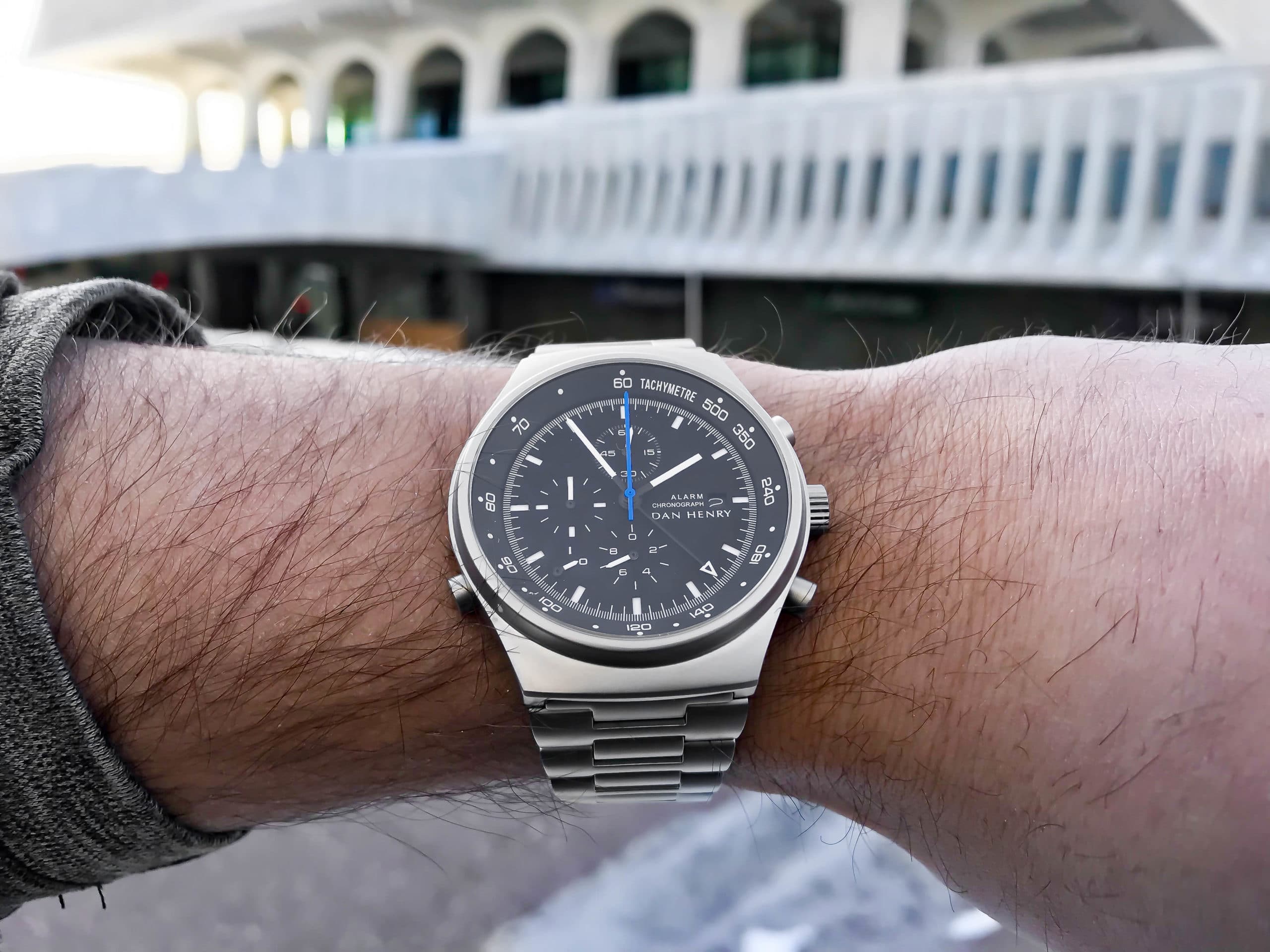
“This Watch has no running seconds” … this is not true. When the chrono is off, you can choose the 6 o’clock sub dial to show the running seconds or not by pressing the 4 o’clock pusher. This is described in the manual.
That is true, but the one received was crap for other reasons. The chrono mi ute would not reset to 0. Then it decided progressively each time I used the chronograph the the ending minute position was the new 0. The online user manual, super cheap by the way not to have a printed user’s manual, provided instructions to adjust the 0 position of the second hand and the 1/20th second hand but not for the Chrono minute hand. It did however say the chrono minute hand position was directly tied to the second hand. Holding the A button until the second hand brought the chrono minute hand back to 0. Then finish the reser and the chronominute would go back to its misaligned position.
It’s the last miyota movement in will consider, Dan Heney I might consider again. I also could have also waited a month and bought genuine Porche Design Orfina. Then at least there would be am excuse for it not performing perfectly, it is vintage.
Until then caveat emptor